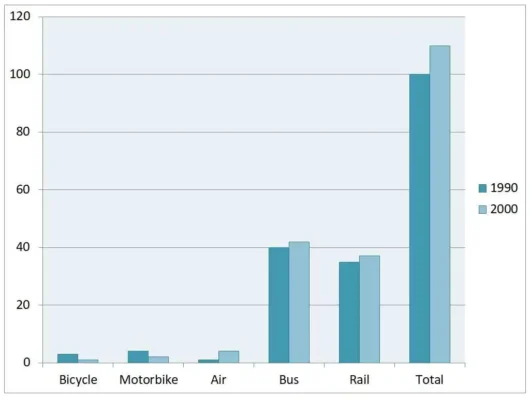-
IELTS Academic Task 1: Distances Travelled Bar Chart
Posted by NIL Admin on August 15, 2021 at 8:41 PMThe chart illustrates distances travelled per person per week (in kilometres) in terms of 5 types of transport in the UK between 1990 and 2000.
The bar chart details the changes in travel habits by mode of transport in 1990 and 2000 in the UK. Looking from an overall perspective, it is readily apparent that the rise in total figures over the period was a result of increases from rail, bus and air as bicycle and motorbike usage fell. The most common forms of travel were by far bus and rail.
Looking first of all at the two leaders, busing accounted for precisely 40 kilometres in 1990, before a small increase to 42 by 2000. Rail was lower in both periods at 36 and 38 km, respectively.
The less used modes of transport were all below 5 km a week. Bicycles started at 2 and fell to 1 km while motorbikes halved from 4 to 2 km. Finally, air in 1990 was just above 1 but had quadrupled to 4 km per month per person by 2000.
Overall totals constituted 100 km in 1990 and a subsequent 110 by the end of the period surveyed.
Falak replied 2 years, 11 months ago 6 Members · 9 Replies -
9 Replies
-
Analysis:
1. The bar chart details the changes in travel habits by mode of transport in 1990 and 2000 in the UK. 2. Looking from an overall perspective, it is readily apparent that the rise in total figures over the period was a result of increases from rail, bus and air as bicycle and motorbike usage fell. 3. The most common forms of travel were by far bus and rail.
1. Paraphrase what the graph shows.
2. Write a clear overview summarising the major trends and differences.
3. Add an extra sentence to be sure that you have covered everything.
Looking first of all at the two leaders, busing accounted for precisely 40 kilometres in 1990, before a small increase to 42 by 2000. 2. Rail was lower in both periods at 36 and 38 km, respectively.
1. Begin writing about the differences.
2. Compare as much as possible.
The less used modes of transport were all below 5 km a week. 2. Bicycles started at 2 and fell to 1 km while motorbikes halved from 4 to 2 km. 3. Finally, air in 1990 was just above 1 but had quadrupled to 4 km per month per person by 2000.
1. Write about the rest of the information.
2. Make sure you have detailed all the information.
3. Don’t leave anything out!
Overall totals constituted 100 km in 1990 and a subsequent 110 by the end of the period surveyed.
1. The total is also important to mention.
-
The chart depicts the distance patterns of people in kilometres on the weekly basis for 5 modes of transport over a decade (1990 – 2000). It can be clearly seen that the use of commercial transports buses and rails had a major impact for large distances travelled, in comparison to the other means of transport air, motorbike and bicycle.
The data suggests that the dependency of bus was more in the decade than any other facilities for transportation gradually increasing from 40 km to just over 42 km. It is worth noting that the trains were also not behind with approximately 35km in 1990 with a marginal increase roughly around 38km.
It is interesting to note that the dependency over bicycle has declined significantly from almost 5 km to nearly 2km. Now turning over the details for motorbike and air, the bikes usage had seen a marginal fall from around 7 km in 1990 to just under 5km in 2000. On the other hand, flights had seen a climb from 1 km to 5 km in the next 10 years which is worth noting.
<font face=”inherit”>Overall, we can conclude from the illustration that the use of transports </font>soared<font face=”inherit”> by 10 km i.e from (100 to 110)km. </font>
-
The chart provides information about distance travel by an individual per week on different modes of transportation in the UK from 1990 and 2000.
Overall, it has noticed an increase in figure had shown a drastic change over a period, hence as a result bus and rail outraced bicycle, motorbike and air in covering interval by person per week. The chart clearly shows that there is huge demand of public transport in 1990 and 2000 respectively.
According to the graph the two leaders has captured the majority of share approximately by 40 km and 35km in 1990 and about 42km and 38km in 2000 respectively. Bicycle has touched 5km and motorbike gradually shown an increase by 7 km in 1990 whereas on the other side, air has reached its low point at 2 km in 1991 compared to other mode of transport.
Secondly, Bicycle dipped down by 2 km in the year 2000 and Motorbike and air rose by 7 km and 10 km over the period. Well bus has few like rocket in 2000 by 42 km and reached its highest point leaving rail behind by just tiny fraction.
-
The Bar chart provides the insights about the changes in travel habits by mode of transport in 1990 and 2000 in UK
Overall, the data shown reveals that travelling in has slightly increased from 1990 to 2000. The increase in travelling in 2000 was majorly due to marginal increase in bus and rail transport and drastic increase approximately double in air
As it can be seen from the graph that majority of the travel in both the years was through bus and rail, where bus is leading by a marginal differences. Comparing it over years we can say that mode of transport through bus has increase by a tiny fraction from 1990 to 2000 which same for rail as well. Contradicting trend was observed for Bicycle and Motorbike where we saw a dip in kilometers which approximately halved from 1990 to 2000. Air mode of transport was observed to have rocket increase from 1990 to 2000 approximately double. -
Hi Falak,
Here is my second Writing task 1:
The bar chart depicts the information about distances(in kilometres) covered by each person each week on 5 different modes of transport from 1990 to 2000 in UK.
Overall, it can be seen clearly that both the year (i.e. 1990 and 2000) covered the maximum distance from bus and rail which made a major rise in total category by individuals. Whereas, bicycle and air were the least choices for people to travelled through.
In 1990, bicycle was able to cover almost 3 km of distance despite being a first mode of transport. Then, 1 km got increased by those people who commuted through motorbike. Air was the least preferrable transportation through which people travelled around 1%. However, bus and rail were the best and cheap choice for each person for travelling as both covered majority of kilometres (i.e. 40% and almost 37% respectively).
In 2000, each individual travelled drastically less(1 km) on bicycle just like people who commuted through air in 1990. There was a 1 km difference in distances travelled by people through motorbike and air. Similarly, bus and rail were the most preferable choices for every individual to commute which covered the highest numbers of kilometres as around 41% and 38%.
-
In 1990, bicycle was able to cover almost 3 km of distance despite being a first mode of transport.(how bicycle is established as first mode of transportation from the graph)
However, bus and rail were the best and cheap choice (it is not mentioned anywhere in the bar graph that bus and rail are cheap choices ) for each person for travelling as both covered majority of kilometres (i.e. 40% and almost 37% respectively).
Similarly, bus and rail( managed to be) the most preferable choices for every individual to commute which covered the highest numbers of kilometres as around 41% and 38% (respectively)
Feedback : Interpretation of the contrasts ,comparison and pattern could be better
Band : 1.5/3
-
Log in to reply.



